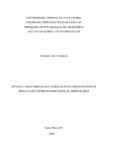| dc.creator | Beck, Thaíssa Silva | |
| dc.date.accessioned | 2021-11-29T15:28:15Z | |
| dc.date.available | 2021-11-29T15:28:15Z | |
| dc.date.issued | 2020-02-20 | |
| dc.identifier.uri | http://repositorio.ufsm.br/handle/1/23047 | |
| dc.description.abstract | This study presents the synthesis and characterization of mono and dicationic ionic liquids (ILs), with anions derived from amino acids (Arginine, Glycine, Lysine and Serine). The influence of the molecular structure of ILs in the aggregates formation in solution were also realized. The characterization of ILs was performed using 1H and 13C Nuclear Magnetic Resonance (NMR), Electrospray Ionization Mass Spectrometry (ESI- MS-MS), Thermogravimetric Analysis (TGA) and Differential Scanning Calorimetry (DSC). The results showed that monocationic ILs have lower thermal stability than dicationic ILs, with the exception of [BisDec(MIM)2][GLI]. All ILs are less stable than analogous ILs with counterion bromide. From DSC, it was observed that the ILs presented only glass transition in the monitored temperature range. The aggregation behavior in aqueous solution of ILs was investigated using electrical conductivity and 1H NMR. The results showed that dicationic ILs aggregate more easily than monocationic ones. This result was related to the anions hydrophobicity of the anion influenced CAC more than the hydrophobicity of the cation. The chemical shift of the 1H of the imidazole (polar head) and the side/spacer chain (apolar part) of the ILs showed an increase in the chemical shift. Except for the IL [BisDec(MIM)2][2GLI] that all 1H signals showed a decrease as the aggregation occurred. The CAC obtained by conductivity and 1H NMR showed the same trend. The higher the hydrophobicity of the anion, the lower the CAC. | eng |
| dc.description.sponsorship | Coordenação de Aperfeiçoamento de Pessoal de Nível Superior - CAPES | por |
| dc.language | por | por |
| dc.publisher | Universidade Federal de Santa Maria | por |
| dc.rights | Attribution-NonCommercial-NoDerivatives 4.0 International | * |
| dc.rights.uri | http://creativecommons.org/licenses/by-nc-nd/4.0/ | * |
| dc.subject | Líquidos iônicos derivados de aminoácidos | por |
| dc.subject | Monocatiônicos | por |
| dc.subject | Dicatiônicos | por |
| dc.subject | Estabilidade térmica | por |
| dc.subject | Agregação | por |
| dc.subject | Amino acid-based Ionic liquids | eng |
| dc.subject | Monocationic | eng |
| dc.subject | Dicationic | eng |
| dc.subject | Thermal stability | eng |
| dc.subject | Aggregation | eng |
| dc.title | Síntese, caracterização e agregação de líquidos iônicos mono- e dicatiônicos derivados de aminoácidos | por |
| dc.title.alternative | Synthesis, characterization and aggregation of amino acid-based ionic liquids monocationic and dicationic | eng |
| dc.type | Dissertação | por |
| dc.description.resumo | Este trabalho apresenta a síntese, caracterização e estudo da influência da estrutura molecular dos líquidos iônicos (LIs) mono e dicatiônicos com ânions derivados dos aminoácidos arginina, glicina, lisina e serina na formação de agregados em solução aquosa. A caracterização dos LIs foi realizada por ressonância magnética nuclear (RMN) de 1H e 13C, espectrometria de massas, análise termogravimétrica (TGA) e calorimetria exploratória diferencial (DSC). Os resultados mostraram que os LIs monocatiônicos apresentam estabilidade térmica inferior que os LIs dicatiônicos, com exceção do [BisDec(MIM)2][GLI]. Todos os LIs são menos estáveis que seus análogos com ânion brometo. Os LIs estudados são amorfos na faixa de temperatura monitorada. O comportamento de agregação em solução aquosa dos LIs foi investigado usando condutividade elétrica e RMN de 1H. Os resultados mostraram que os LIs dicatiônicos agregam mais facilmente que os LIs monocatiônicos com o mesmo ânion. Este fato indica que a hidrofobicidade do ânion teve mais efeito do que a hidrofobicidade do cátion na CAC. O deslocamentoquímicos dos 1H do imidazol (cabeça polar) e da cadeia lateral/espaçadora (parte apolar) de todos os LIs apresentaram aumento do deslocamento químico. Exceto para o LI [BisDec(MIM)2][2GLI] que todos os sinais apresentaram uma diminuição à medida que a agregação ocorreu. A CAC obtida por condutividade e 1H RMN apresentou a mesma tendência na qual quanto maior a hidrofobicidade do ânion, menor a CAC. | por |
| dc.contributor.advisor1 | Frizzo, Clarissa Piccinin | |
| dc.contributor.advisor1Lattes | http://lattes.cnpq.br/0029279904716491 | por |
| dc.contributor.advisor-co1 | Villetti, Marcos Antonio | |
| dc.contributor.referee1 | Schumacher, Ricardo Frederico | |
| dc.contributor.referee2 | Verly, Rodrigo Moreira | |
| dc.creator.Lattes | http://lattes.cnpq.br/2434758269044767 | por |
| dc.publisher.country | Brasil | por |
| dc.publisher.department | Química | por |
| dc.publisher.initials | UFSM | por |
| dc.publisher.program | Programa de Pós-Graduação em Química | por |
| dc.subject.cnpq | CNPQ::CIENCIAS EXATAS E DA TERRA::QUIMICA | por |
| dc.publisher.unidade | Centro de Ciências Naturais e Exatas | por |



